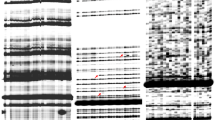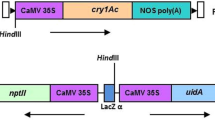Abstract
Transposon-mediated repositioning of transgenes is an attractive strategy to generate plants that are free of selectable markers and T-DNA inserts. By using a minimal number of transformation events a large number of transgene insertions in the genome can be obtained so as to benefit from position effects in the genome that can contribute to higher levels of expression. We constructed a Bacillus thuringiensis synthetic cry1B gene expressed under control of the maize ubiquitin promoter between minimal terminal inverted repeats of the maize Ac-Ds transposon system, which was cloned in the 5' untranslated sequence of a gfp gene used as an excision marker. The T-DNA also harboured the Ac transposase gene driven by the CaMV 35S promoter and the hph gene conferring resistance to the antibiotic hygromycin. Sixty-eight independent rice (Oryza sativa L.) transformants were regenerated and molecularly analysed revealing excision and reinsertion of the Ds-cry1B element in 37% and 25% respectively of the transformation events. Five independent transformants harbouring 2–4 reinserted Ds-Cry1B copies were analysed in the T1 progeny, revealing 0.2 to 1.4 new transpositions per plant. Out segregation of the cry1B gene from the T-DNA insertion site was observed in 17 T1 plants, representing 10 independent repositioning events without selection. Western analysis of leaf protein extracts of these plants revealed detectable Cry1B in all the plants indicating efficient expression of the transgene reinsertions. Stability of position and expression of the cry1B transgene was further confirmed in T2 progeny of T-DNA-free T1 plants. New T-DNA-free repositioning events were also identified in T2 progenies of T1 plants heterozygous for the T-DNA. Furthermore, preliminary whole plant bioassay of T-DNA-free lines challenged with striped stem borer larvae suggested that they are protected against SSB attacks. These results indicate that transposon mediated relocation of the gene of interest is a powerful method for generating T-DNA integration site-free transgenic plants and exploiting favourable position effects in the plant genome.
Similar content being viewed by others
References
Bohorova N., Frutos R., Royer M., Estanol P., Pacheco M., Rascon Q. et al. 2001. Novel synthetic Bacillus thuringiensis cry1B gene and the cry1B-cry1Ab translational fusion confer resistance to southwestern corn borer, sugarcane borer and fall armyworm in transgenic tropical maize. Theor Appl. Genet. 103: 817–826.
Bradford M. 1976. A rapid and sensitive method for the quantifi-cation of microgram quantities of protein utilizing the principle of protein-dye binding. Annal. Biochem. 72: 248–254.
Chen L., Zhang S., Beachy R.N. and Fauquet C.M. 1998. A protocol for consistent, large scale production of fertile transgenic rice plants. Plant Cell Rep. 18: 25–31.
Chin H.G., Choe M.S., Lee S.H., Park S.H., Park S.H., Koo J.C. et al. 1999. Molecular analysis of rice plants harboring an Ac/Ds transposable element-mediated gene trapping system. Plant J. 19: 615–623.
Chiu W., Niwa Y., Zeng W., Hirano T., Kobayashi H. and Sheen J. 1996. Engineered GFP as a vital reporter in plants. Curr. Biol. 6: 325–330.
Christensen A. and Quail P.H. 1996. Ubiquitin promoter-based vectors for high level expression of selectable and/or screenable marker genes in monocotyledonous plants. Transgenic Res. 5: 213–218.
Dale E.C. and Ow D.W. 1991. Gene transfer with subsequent removal of the selection gene from the host genome. Proc. Natl Acad. Sci U.S.A 88: 10558–10562.
Daley M., Knauf V.C., Summerfelt K.R. and Turner J.C. 1998. Cotransformation with one Agrobacterium tumefaciens strain containing two binary plasmids as a method for producing markerfree plants. Plant Cell Rep. 17: 489–496.
De Block M. and Debrouwer D. 1991. Two T-DNA's co-transformed in Brassica napus by a double Agrobacterium infection are mainly integrated at the same locus. Theor Appl. Genet. 82: 257–262.
De Buck S., De Wilde C., Van Montagu M. and Depicker A. 2000. T-DNA vector backbone sequences are frequently integrated into the genome of transgenic plants obtained by Agrobacterium-mediated transformation. Mol. Breed. 6: 459–468.
Enoki H., Izawa T., Kawahara M., Komatsu M., Koh S., Kyozuka J. et al. 1999. Ac as a tool for the functional genomics of rice. Plant J. 19: 605–613.
Gleave A.P., Mitra D.S., Mudge S.R. and Morris B.A. 1999. Selectable marker-free transgenic plants without sexual crossing: transient expression of cre recombinase and use of a conditional lethal dominant gene. Plant Mol. Biol. 40: 223–235.
Goldsbrough A.P., Lastrella C.N. and Yoder J.I. 1993. Transposition mediated re-positioning and subsequent elimination of marker gene from transgenic tomato. Bio/Technology 11: 1286–1292.
Greco R., Ouwerkerk P.B.F., Sallaud C., Kohli A., Colombo L., Puigdomenech P. et al. 2001a. Transposon Insertional Mutagenesis in rice. Plant Physiol. 125: 1175–1177.
Greco R., Ouwerkerk P.B.F., Taal A.J.C., Favalli C., Beguiristain T., Puigdomenech P. et al. 2001b. Early and multiple Ac transpositions in rice generated by an adjacent strong enhancer. Plant Mol. Biol. 46: 215–227.
Hansen G. and Wright M.S. 1999. Recent advances in the transformation of plants. Trends Plant Sci. 4: 226–231.
Hohn B., Levy A.A. and Puchta H. 2001. Elimination of selection markers from transgenic plants. Curr. Opin. In Biotech 12: 139–143.
Kohli A., Xiong J., Greco R., Christou P. and Pereira A. 2001. Tagged transcriptome display (TTD) in indica rice using Ac transposon. Mol. Genet. Genomics 266: 1–11.
Komari T., Hiei Y., Saito Y., Murai N. and Kumashiro T. 1996. Vectors carrying two separate T-DNAs for co-transformation of higher plants mediated by Agrobacterium tumefaciens and segregation of transformants free from selection markers. Plant J. 10: 165–174.
Koprek T., Rangel S., Mc elroy D., Louwerse J.D., Williams Carrier R.E. and Lemaux P.G. 2001. Transposon-mediated single copy gene delivery leads to increased transgene expression stability in barley. Plant Physiol. 125: 1354–1362.
Hoisington D. 1992. Laboratory Protocols. CIMMYT, Mexico DF.
Hood E.E., Gelvin S.B., Melchers L.S. and Hoekema A. 1993. New Agrobacterium helper plasmids for gene transfer to plants. Transgenic Res. 2: 208–218.
Izawa T., Miyazaki C., Yamamoto M., Terada R., Iida S. and Shimamoto K. 1991. Introduction and transposition of the maize transposable element Ac in rice (Oryza sativa L.). Mol. Gen. Genet. 227: 391–396.
Izawa T., Ohnishi T., Nakano T., Ishida H., Enoki H., Hashimoto K. et al. 1997. Transposon tagging in rice. Plant Mol. Biol. 35: 219–229.
Laemmli U. 1970. Cleavage of structural proteins during the assembly of the head of bacteriophage T4. Nature 227: 680–685.
Mc Knight T.D., Lillis M.T. and Simpson R.B. 1987. Segregation of genes transferred to one plant cell from two separate Agrobacterium strains. Plant Mol. Biol. 8: 439–445.
Mao L., Wood T.C., Yu Y., Budiman M.A., Tomkins J., Woo S.S. et al. 2000. Rice transposable elements: A survey of 73,000 sequence-tagged-connectors. Genome Res. 10: 982–990.
Nakagawa Y., Machida C., Machida Y. and Toriyama K. 2000. Frequency and pattern of transposition of the maize transposable element Ds in transgenic rice plants. Plant Cell Physiol. 41: 733–742.
Sambrook J., Fritsch E.F. and Maniatis T. 1989. Molecular cloning: a laboratory manual. 2nd edn. Cold Spring Harbor Laboratory, Cold Spring Harbor, NY, USA.
Shimamoto K., Myazaki C., Hashimoto H., Izawa T., Itoh K., Terada R. et al. 1993. Trans-activation and stable integration of the maize transposable element Ds cotransfected with the Ac transposase gene in transgenic rice plants. Mol. Gen. Genet. 239: 354–360.
Sijmons P.C., Dekker B.M., Scrammeijer N., Verwoerd T.C., van den Eck and Hoekema A. 1990. Production of correctly processed human serum albumin in plants. Bio/Technology 8: 217–221.
Smith N., Kilpatrick J.B. and Whitelam G.C. 2001. Superfluous transgene integration in plants. Crit. Rev. Plant Sci. 20: 215–249.
Speulman E., Metz P.L., van Arkel G., Lintel Hekkert B.T., Stiekema W.J. and Pereira A. 1999. A two-component Enhancer/ inhibitor transposon mutagenesis system for functional analysis of the Arabidopsis genome. Plant Cell 11: 1853–1866.
Sugita K., Matsunaga E. and Ebinuma H. 1999. Effective selection system for generating marker-free transgenic plants independent of sexual crossing. Plant Cell Rep. 18: 941–947.
Tyagi A.K. and Mohanty A. 2000. Rice transformation for crop improvement and functional genomics. Plant Sci. 158: 1–18.
Tu J., Zhang G., Datta K., Xu C., He Y., Zhang Q. et al. 2001. Field performance of transgenic elite commercial hybrid rice expressing Bacillus thuringiensis endotoxin. Nat. Biotech. 18: 1101–1104.
Wang M.B., Upadhyaya N.M., Brettell R.I.S. and Waterhouse P.M. 1997. Intron-mediated improvement of a selectable marker gene for plant transformation using Agrobacterium tumefaciens. J. Genet. Breed. 51: 325–334.
Yin Z. and Wang G.L. 2000. Evidence of multiple complex patterns of T-DNA integration into the rice genome. Theor. Appl. Genet. 100: 461–470.
Yoder J.I. and Goldsbrough A.P. 1994. Transformation systems for generating marker-free transgenic plants. Bio/Technology 12: 263–267.
Zubko E., Scutt C. and Meyer P. 2000. Intrachromosomal recombination between attP regions as a tool to remove selectable marker genes from tobacco transgenes. Nat. Biotech. 18: 442–445.
Zuo J., Niu Q.W., Moller S.G. and Chua M.H. 2001. Chemicalregulated, site specific DNA excision in transgenic plants. Nat. Biotech. 19: 157–161.
Author information
Authors and Affiliations
Corresponding author
Rights and permissions
About this article
Cite this article
Cotsaftis, O., Sallaud, C., Breitler, J.C. et al. Transposon-mediated generation of T-DNA- and marker-free rice plants expressing a Bt endotoxin gene. Molecular Breeding 10, 165–180 (2002). https://doi.org/10.1023/A:1020380305904
Issue Date:
DOI: https://doi.org/10.1023/A:1020380305904




